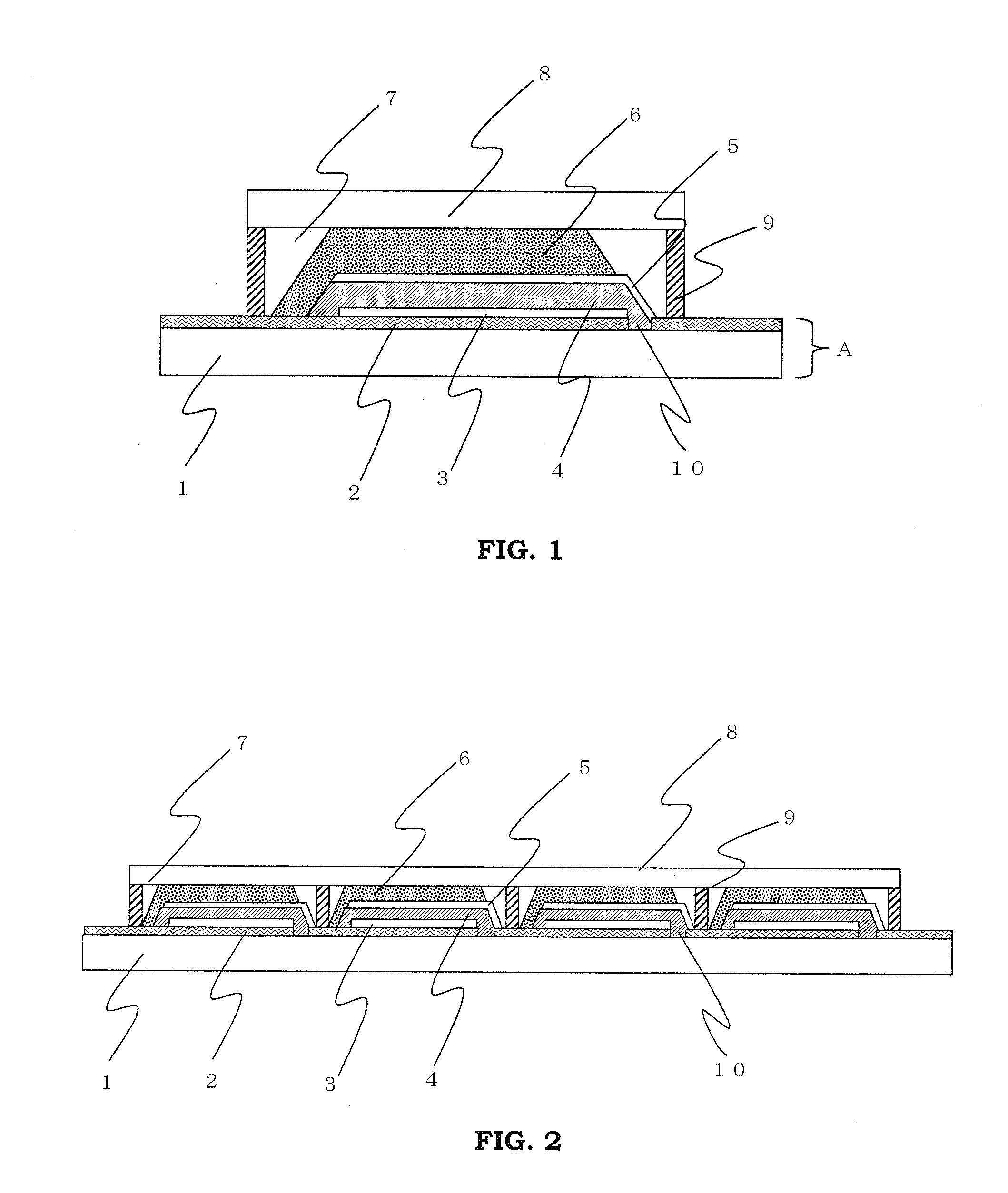Dye-sensitized solar cell and dye-sensitized solar cell module
- Summary
- Abstract
- Description
- Claims
- Application Information
AI Technical Summary
Benefits of technology
Problems solved by technology
Method used
Image
Examples
embodiment 1-1
[0043]FIG. 1 is a schematic cross sectional view showing the layer configuration of main parts of a solar cell (Embodiment 1-1) of the present invention.
[0044]This solar cell is of a type having a second conductive layer 5 formed on a porous insulating layer 4, and specifically, the solar cell is provided with a conductive substrate A obtained by forming a first conductive layer 2 on a substrate 1; a catalyst layer 3, a porous insulating layer 4, a second conductive layer 5, a porous semiconductor layer 6 adsorbing a sensitizing dye, and a translucent cover member 8 formed subsequently on the first conductive layer 2, and the porous insulating layer 4 and the porous semiconductor layer 6 each contain an electrolyte 7. Further, a sealing part 9 is formed in the outer circumferential parts between the conductive substrate A and the translucent cover member 8.
[0045]The first conductive layer 2 has a scribe line 10 formed by removing a portion of the layer in the inside region near the ...
embodiment 1-2
[0130]FIG. 2 is a schematic cross sectional view showing the layer configuration of main parts of a solar cell module (Embodiment 1-2) obtained by electrically connecting in series a plurality of solar cells (Embodiment 1-1) of the present invention.
[0131]This solar cell module can be produced as follows.
[0132]First, a first conductive layer formed on a substrate 1 is patterned by a laser scribing method at prescribed intervals to form a plurality of scribe lines in which the conductive layer is removed. Therefore, a plurality of mutually electrically separated first conductive layers 2 are formed and solar cell formation regions are provided on the respective first conductive layers 2.
[0133]Among the plurality of the first conductive layers 2, the first conductive layer 2 at one end in the direction perpendicular to the scribe lines 10 is formed to have a smaller width, and no solar cell is formed on the first conductive layer 2 with the smaller width. This first conductive layer 2...
embodiment 2-1
[0140]FIG. 3 is a schematic cross sectional view showing the layer configuration of main parts of a solar cell (Embodiment 2-1) of the present invention.
[0141]This solar cell is of a type in which the porous semiconductor layer 6 is formed on the porous insulating layer 4 in Embodiment 1-1 and the second conductive layer 5 is formed on the porous semiconductor layer 6, which is approximately same as that of Embodiment 1-1, except that the porous semiconductor layer 6 is formed on the porous insulating layer 4 so as to stride over the extracting electrode and that the second conductive layer 5 is formed on the porous semiconductor layer 6 so as to stride over the narrower first conductive layer 2. In this solar cell, since the second conductive layer 5 is formed on the porous semiconductor layer 6, the surface roughness coefficient Ra of the porous semiconductor layer 6 is equal to the surface roughness coefficient Ra of the interface of the porous semiconductor layer and the second ...
PUM
 Login to View More
Login to View More Abstract
Description
Claims
Application Information
 Login to View More
Login to View More - R&D
- Intellectual Property
- Life Sciences
- Materials
- Tech Scout
- Unparalleled Data Quality
- Higher Quality Content
- 60% Fewer Hallucinations
Browse by: Latest US Patents, China's latest patents, Technical Efficacy Thesaurus, Application Domain, Technology Topic, Popular Technical Reports.
© 2025 PatSnap. All rights reserved.Legal|Privacy policy|Modern Slavery Act Transparency Statement|Sitemap|About US| Contact US: help@patsnap.com



